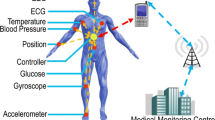Abstract
Wireless Body Area Networks (WBAN) is an emerging area in field of remote health monitoring and telemedicine. UWB is a preferred candidate for the WBAN as it provides very high data rate at minimal cost and power consumption. Since the UWB-WBAN is wireless, it will be affected by interference from existing wireless personal and local area networks. Interference immunity is a major issue in wireless Body Area Networks as patients’ vital data containing details of functioning of vital organs and blood flow are carried. The paper investigates the performance of modified and modulated hermite pulses (MHP) for narrowband interference mitigation in the 4,940–4,990 MHz band IEEE 802.11y Public Safety band interference. This 50 MHz interfering band will be a critical interferer due to the higher power levels of interfering system. Performance of the proposed technique have been shown in comparison with Gaussian pulse shapes and has been further validated by transmitting ECG and MRI data by it in presence of strong interference.





















Similar content being viewed by others
References
Yuce, M. R. (2010). Implementation of wireless body area networks for healthcare systems. Sensors and Actuators A: Physical, 162(1), 116–129.
Yazdandoost, K. Y., & Sayrafian-Pour, K.: Channel model for body area network (BAN). In IEEE channel modelling subcommittee report from IEEE P802.15 working group for Wireless Personal Area Networks (WPANs).
IEEE Standard for Information technology- Local and metropolitan area networks- Specific requirements- Part 11: Wireless LAN Medium Access Control (MAC) and Physical Layer (PHY) Specifications Amendment 3: 3,650–3,700 MHz Operation in USA, IEEE STD 802–11y-2008, vol., no., pp. 1,90 Nov. 3 (2008).
Cui, S., Teh, K. C., Li, K. H., Guan, Y. L., & Law, C. L. (2007). Narrowband interference suppression in transmitted reference UWB systems with inter-pulse interference. In IEEE international conference on ultra-wideband, 2007. ICUWB 2007, vol., no., pp. 895–898, 24–26.
Gao, W., Venkatesan, R., & Li, C. (2007). A pulse shape design method for ultra-wideband communications. In Wireless communications and networking conference, 2007.WCNC 2007. IEEE, vol., no., pp. 2800–2805, 11–15.
Ekome, S. M., Baudoin, G., Villegas, M., & Schwoerer, J. (2012). Narrowband interference mitigation in UWB communication with energy detector. In UltraWideband (ICUWB), 2012 IEEE international conference on (pp. 67–71). IEEE.
Ibrahim, J., & Buehrer, R. M. (2007). NBI mitigation for UWB systems using multiple antenna selection diversity. IEEE Transactions on Vehicular Technology, 56(4), 2363–2374.
Batra, A., et al. (2003). Multi-band OFDM physical layer proposal for IEEE 802.15 task group 3a, IEEE P802.15-03/268r1-TG3a.
IEEE Standard for Information technology-Telecommunications and Information exchange between systems-Local and metropolitan area networks, part 15.3: Wireless Medium Access Control(MAC) and Physical Layer (PHY).
IEEE Standard for Local and metropolitan area networks, Part 15.6: Wireless Body Area, Networks 29 February 2012.
Ghavami, M., Michael, L. B., & Kohno, R. (2007). Ultra wideband signals and systems in communication engineering. London: Wiley.
Siriwongpairat, W. P., & Liu, K. J. R. (2007). Ultra-wideband communications systems: multiband OFDM approach. Wiley-IEEE Press.
Mebaley Ekome, S., Schwoerer, J., Baudoin, G., & Villegas, M.: Performance analysis of a BPSK-BPPM UWB physical layer for wireless Body Area Networks. In Proceedings of the fifth international conference on Body Area Networks (BodyNets ’10). ACM, New York, pp. 105–111.
Taparugssanagorn, A., Pomalaza-Ráez, C., Isola, A., Tesi, R., Hämäläinen, M., & Iinatti, J. (2010). Channel modelling for wireless body area networks in a hospital. International Journal of Ultra Wideband Communications and Systems, 1(4), 226–236.
Takizawa, K., et al. (2008). Channel models for wireless body area networks. In Engineering in medicine and biology society, 2008. EMBS 2008. 30th annual international conference of the IEEE. IEEE.
Fort, A., et al. (2006). An ultra-wideband body area propagation channel model-from statistics to implementation. IEEE Transactions on Microwave Theory and Techniques, 54(4), 1820–1826.
Hamalainen, M., & Iinatti, J. (2005). Analysis of interference on DS-UWB system in AWGN channel. In Ultra-Wideband, 2005. ICU 2005. 2005 IEEE International Conference on, vol., no., pp. 719,723, 5–8.
Peterson, R. L., Ziemer, R. E., & Borth, D. E. (1995). Introduction to spread spectrum communications. Upper Saddle River, New Jersey, USA: Prentice Hall.
Abramowitz, M., & Stegun, I. A. (Eds.) (1972). Orthogonal polynomials. In Ch. 22 in Handbook of Mathematical Functions with Formulas, Graphs, and Mathematical Tables, 9th printing (pp. 771–802). New York: Dover.
Andrew s, G. E., Askey, R., & Roy, R. (1999). Hermite polynomials. §6.1 in special functions. Cambridge, England: Cambridge University Press.
Aoyagi, T., Takada, J., Takizawa, K., Katayama, N., Kobayashi, T., & Yazdandoost, K. Y., et al. (2008). Channel model for wearable and implantable WBANs, IEEE 802.15-08-0416-04-0006.
DeMartini, W. B., Lehman, C. D., Peacock, S., & Russell, M. T. (2005). Computer-aided detection applied to breast MRI: Assessment of CAD-generated enhancement and tumor sizes in breast cancers before and after neoadjuvant chemotherapy1. Academic Radiology, Elsevier, 12(7), 806–814.
Ferraro, S., Biganzoli, E., Marano, G., Santagostino, M., Boracchi, P., Panteghini, M., et al. (2013). New insights in the pathophysiology of acute myocardial infarction detectable by a contemporary troponin assay. Clinical Biochemistry, Elsevier.
Rai, H. M., Trivedi, A., & Shukla, S. (2013). ECG signal processing for abnormalities detection using multi-resolution wavelet transform and artificial neural network classifier, measurement. Elsevier.
Author information
Authors and Affiliations
Corresponding author
Rights and permissions
About this article
Cite this article
Rout, D.K., Das, S. Interference Mitigation in Wireless Body Area Networks Using Modified and Modulated MHP. Wireless Pers Commun 77, 1343–1361 (2014). https://doi.org/10.1007/s11277-013-1584-z
Published:
Issue Date:
DOI: https://doi.org/10.1007/s11277-013-1584-z




